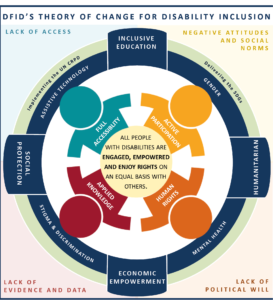By- Megha Agarwal
Abstract:
How does it feel when you unlock your true potential with the power of digitalization? Digital learning is the same essential key for this transformation, empowerment, and holistic growth of rural people in this digital era. This research article explores the significance of digital learning, major government initiatives such as Digital India Mission, PMGDISHA and NDLM, and various challenges faced by rural people in order to inculcate digital literacy in their lives. Along with different aspects of digital literacy, we also shed light upon the empowerment solutions for a sustainable change in rural India.
1.0 Introduction:
What if every village got access to digital learning? Imagine the future of India. This vision unleashes the transformation of a sustainable route towards digital learning and bridging the digital literacy gap in rural India. Digital literacy is the ability of the individual to utilize the various digital platforms, evaluate, and compose productive information through writing and other media on various digital platforms (Maruthi & Sarvamangala, 2023). Over 60% of India’s population resides in rural regions, where digitalization ensures to grant benefits of the modern economy, innovation, and connectivity (Reji & et al., 2024). Digital learning is a key step towards the Integrated Digital India Mission.
However, in rural India, digital learning depends on a detailed comprehension of the socio-cultural context, infrastructure difficulties, and the cooperative endeavors of government entities, non-governmental organizations, and the private sector (Hans, 2024). Despite the digital divide posing an obstacle in the pathway of sustainability, by bridging this gap through digital literacy and promoting cashless transactions and providing useful resources and health cards, digitalization can ensure marginalized communities benefit from digital technologies (Sinkadi & Showkat, 2024). By understanding the pivotal role of technology in unlocking the latent potential of e-learning, we strive towards a vision of an inclusive and empowered rural India, where digital tools serve as catalysts for sustainable development and equitable growth. (Bruntha & Subaithani, 2024).
2.0 Significance of e-learning in Rural India:
Digital learning is an important asset for the holistic development of rural India. It laid down focus upon how fundamentally technology functions and how to use its many tools and gadgets effectively. It is essential to thriving in the contemporary tech-dominated environment (Kumar & Jain, 2023). It empowers communities to generate digital content, communicate and work together, solve problems, and develop advanced digital skills that have higher-level abilities and make digital transformations such as artificial intelligence (AI), machine learning, big data analytics, and capacity building. (Ganeshan, 2024).
Digital awareness & tools play a vital role in the digitalization of India, and providing speed network connectivity to rural India has helped many villages to develop (Bhattacharya & Sachdev, 2022). Digital education opens an opportunity for inclusive growth & unlocks the potential of various opportunities. It can improve education, make learning more personalized, and adapt students to the future digital world(Vats, 2024). There is optimism that digital education can assist in reducing the high dropout rates In school, issues related to classroom techniques, and unproven strategies(Chowdhry, 2021). Digital learning can be the game changer for rural India.
2.1. Key Aspects of Digital Literacy:
Digital literacy empowers individuals for a better change. It creates a lifelong impact of quality learning & inclusive growth. Digital literacy is still a big challenge, though it is working in the advancement of rural India. There are various aspects that empower rural communities. Digital connectivity can change the picture of the country with the coming up of e-governance, e-education, e-health, e-shopping, digital signatures, and many other facilities. Life has become easier(Bhattacharya & Sachdev, 2022). Digital tools can be tailored to meet the needs of diverse learners, including those with disabilities(Subramani, 2024).
Digital learning can lead to environmental sustainability by using smart, eco-friendly agricultural technology (Patel, 2024). Digitization and technology can facilitate access to and availability of more and more services and products to meet the rising aspirations of the underserved and unreached rural India (Silayo & Bano, 2023). Digital learning can reshape the future of rural India by bridging the gap between digital literacy and business skills. It can harness digital technologies for entrepreneurial ventures, access new markets, and improve overall business operations. (Kaakandikar, 2024).
2.2. Major Challenges in the Route of Digital Learning: Despite digitalization’s progress, rural people are still facing various challenges. There are major concerns that create a hurdle in digital literacy:
1. Training of teachers: Digital aids may not replace teachers but equip them with the power of digital technology. Trainings must be imparted to teachers so that they can handle digital aids properly in classrooms. (Mirza et al., 2018)
2. Lack of digital awareness: In India, lack of easy digital access, poverty, lack of infrastructure, and gender differentiation are a few of the reasons that are holding back the progress in rural education. (Sridhar, 2020)
3. Disappropriated Tools: This poses a problem to digital empowerment because different manufacturers use different operating systems, and this leads to problems in data exchange in e-government applications. (Ashok & Abhishek, 2018)
4. Digital illiteracy: A considerable section of the rural population falls short of the requisite internet bandwidth and expertise to identify gadgets and digital terminology. (Jain, 2022)
5. Digital Divide: The digital divide is one of the major challenges in India. The imbalance may exist between urban and provincial regions, men and ladies, taught and uneducated people, and different social classes, and this is creating a hurdle in the pathway of digital India. (Sahu et al., 2023)
2.3. Digital Empowerment of Rural Communities:
To address the above challenges and enhance & integrate rural communities with digital literacy, the Indian government has started several initiatives. This include Spoken Tutorial in 2009, National Digital Literacy Mission (NDLM) launched in 2014, the Pradhan Mantri Gramin Digital Saksharta Abhiyan, also known as Prime Minister’s Village Digital Literacy Mission (PMGDISHA), in 2017 (Radovanovic & et al., 2020), and BharatNet (Mishra & Ghumre, 2023). E-Kranti (Kedar, 2022), Digital India Campaign (Nazeerudin & et al., 2024), Digital Village (Bhatt, 2020), e-Panchayat (Saha & et al., 2023)
2.4. Solutions: Along with Government Initiatives, we can also focus on some others areas which can lead to a sustainable change:
1. In order to bridge the digital gap in rural areas, we should inculcate digital literacy programs more often in the form of school curriculum activities or in gram panchayat activities.
2. Spreading awareness about the benefits of digitalization can lead to fostering an inclusive environment around the rural people in India.
3. Digital empowerment stories in rural areas can create a better change for the future generations. We should share the insights about the transformation phase of digitalization in rural development.
4. Rural People more often engage in their own native languages; we should ensure that all e-learning apps are working in a more inclusive, feasible way so that people can connect and understand the prospect altogether.
5. E-learning is a gateway to various opportunities; there should be a roadmap, infrastructure, and good internet facilities for learners in their own locality so that they can develop their skills from their places and transform their lives by using the right way of technology.
3.0. Conclusion:
Digital learning is reshaping the future of rural communities in India. However, we couldn’t deny the fact that there are still several barriers in the way of the Digital India Mission in rural regions. Though along with Indian government initiatives, we really need to take a step ahead by spreading awareness, by providing quality learning, and by providing various opportunities in school, at home, or in every path of rural people. And by bridging this digital gap in rural areas, we can empower rural communities by embracing an inclusive culture that matches the needs of rural people in this digital era.
References:
1. Ashok & Abhishek (2018). Digital empowerment of rural people – issues and challenges. Seshadripuram Journal of Social Sciences. https://www.researchgate.net/publication/329277381_Digital_empowerment_of_rural_people-issues_and_challenges
2. Burntha,P & Subaithani, S (2024). A CONCEPTUAL STUDY ON HOW DIGITAL INCLUSION IS RESHAPING RURAL INDIA. ICSSR Sponsored International Seminar on “Building a Cognitive Enterprise Through AI – Powered transformation: A Digital Paradigm for Societal and Tribunal Success in Rural Areas”. https://www.researchgate.net/publication/383094243_A_CONCEPTUAL_STUDY_ON_HOW_DIGITAL_INCLUSION_IS_RESHAPING_RURAL_INDIA
3. Bhattacharya,S & Sachdev, B (2022). Revamping of Digital India to promote a quality management in several sectors to maintain sustainable growth and management in India Subcontinent. International Journal of Scientific Development and Research. https://www.researchgate.net/publication/362124213_Revamping_of_Digital_India_to_promote_a_quality_management_in_several_sectors_to_maintain_sustainable_growth_and_management_in_India_subcontinent
4. Bhatt, S. (2022) Digitalization of Rural India: Digital Village. VISION Journal of Indian Taxation. https://www.researchgate.net/publication/342665840_Digitalization_of_Rural_India_Digital_Village
5. Ganeshan, M. (2024). Digital Skills to Enhance Women’s Empowerment in India. International Journal of Current Researches in Sciences, Social Sciences and Languages. https://www.researchgate.net/publication/383498528_Digital_Skills_to_Enhance_Women’s_Empowerment_in_India
6. Hans, B. (2024). E-Learning for Rural Development in India: Closing Disparities and Empowering Communities. https://papers.ssrn.com/sol3/Delivery.cfm/SSRN_ID4702168_code849898.pdf?abstract_id=4702168&mirid=1&type=2
7. Jain, S. (2022). ONLINE EDUCATION IS A BARRIER TO THE RIGHT TO EDUCATION IN RURAL INDIA. Indian Journal of Integrated Research in Law.
https://ijirl.com/wp-content/uploads/2022/07/ONLINE-EDUCATION-IS-A-BARRIER-TO-THE-RIGHT-TO-EDUCATION-IN-RURAL-INDIA.pdf
8. Kedar, M. (2022). Digital India New way of Innovating India Digitally. INTERNATIONAL RESEARCH JOURNAL OF MULTIDISCIPLINARY STUDIES. https://www.researchgate.net/publication/359369935_Digital_India_New_way_of_Innovating_India_Digitally
9. Kumar, P. & Jain,J. (2023). Digitalization & Its impact on inhabitation of India through digital products and services. International Journal of Innovations & Research Analysis (IJIRA) https://www.researchgate.net/publication/374738770_DIGITALIZATION_ITS_IMPACT_ON_INHABITANTS_OF_INDIA_THROUGH_DIGITAL_INDIA_PRODUCT_AND_SERVICES
10. Kaakandikar, R. et al,. (2024). Digital Literacy Impact on Rural Business Skills: A Study from India. The International Journal of Learner Diversity and Identities. https://www.researchgate.net/publication/379896121_Digital_Literacy_Impact_on_Rural_Business_Skills_A_Study_from_India
11. Maruthi & Sarvamangala (2023). A STUDY ON DIGITAL LITERACY AMONG RURAL CITIZENS ON DIGITAL INDIA. PARIPEX – INDIAN JOURNAL OF RESEARCH. Volume – 1 https://www.worldwidejournals.com/paripex/recent_issues_pdf/2023/December/a-study-on-digital-literacy-among-rural-citizens-on-digital-india_December_2023_1024612178_7107180.pdf
12. Mirza. T, et al., (2018). Improving Education in Rural India with the aid of Digital libraries. International Journal of Research in Advent Technology. https://www.researchgate.net/publication/340738642_Improving_Education_in_Rural_India_with_the_aid_of_Digital_libraries
13. Mishra,S & Ghumre, N (2023). DIGITAL INCLUSION OF RURAL INDIA. EPRA International Journal of Multidisciplinary Research (IJMR). https://www.researchgate.net/publication/383312656_DIGITAL_INCLUSION_OF_RURAL_INDIA
14. Nazeerudin et al, (2024). Transformative Initiatives for Rural India’s Digital Inclusion. International Journal of Humanities Social Science and Management. https://ijhssm.org/issue_dcp/Transformative%20Initiatives%20for%20Rural%20India%20s%20Digital%20Inclusion.pdf
15. Patel, S. (2024). Perspective of Digital Transformation in Rural India. International Journal of Science and Research. https://www.researchgate.net/publication/379756122_Perspective_of_Digital_Transformation_in_Rural_India
16. Reji,S. et al., (2024). Catalyzing digital transformation: Insights from rural India. Academy of Marketing Studies Journal. https://www.researchgate.net/publication/385142653_Catalyzing_digital_transformation_Insights_from_rural_india
17.Radovanovic, D, et al., (2020). Digital Literacy Key Performance Indicators for Sustainable Development. Social Inclusion, Volume 8, Issue 2, Pages 151–167. https://www.researchgate.net/publication/341383748_Digital_Literacy_Key_Performance_Indicators_for_Sustainable_Development
18. Sahu.A, et al., (2023). Digital Divide: Challenge Of Digital India.IOSR Journal of Business and Management. https://www.iosrjournals.org/iosr-jbm/papers/Vol25-issue10/Ser-2/E2510023541.pdf
19. Saha, M. et al., (2023). ROLE OF THE ‘DIGITAL INDIA’ PROGRAMME IN THE RURAL CONTEXT: A STUDY AT MAUTALA VILLAGE IN WEST BENGAL, INDIA. International Journal of Current Research. https://www.researchgate.net/publication/370248207_ROLE_OF_THE_%27DIGITAL_INDIA%27_PROGRAMME_IN_THE_RURAL_CONTEXT_A_STUDY_AT_MAUTALA_VILLAGE_IN_WEST_BENGAL_INDIA
20. Sindakis, S. & Showkat, G. (2024). The digital revolution in India: bridging the gap in rural technology adoption. Journal of Innovation and Entrepreneurship. https://www.researchgate.net/publication/380573562_The_digital_revolution_in_India_bridging_the_gap_in_rural_technology_adoption
21. Subramani, P. (2024). Role of Digital Technologies in Promoting Social Development through Education Access. https://www.researchgate.net/publication/383156326_Role_of_Digital_Technologies_in_Promoting_Social_Development_through_Education_Access
22. Sridhar, S. (2020) Review Study On Importance Of Rural Education In India. International Journal of Innovative Technology and Research. https://core.ac.uk/download/pdf/327105052.pdf
23. Silayo, D. & Bano, W. (2023). Digital Initiatives in Rural India. https://www.researchgate.net/publication/351371349_Digital_Initiatives_in_Rural_India
24. Vats, S. (2024). NEP 2020: The Future of Digital Learning in India. International Journal of Scientific Research and Engineering Development. https://www.researchgate.net/publication/382907264_NEP2020_The_Future_of_Digital_Learning_in_India




